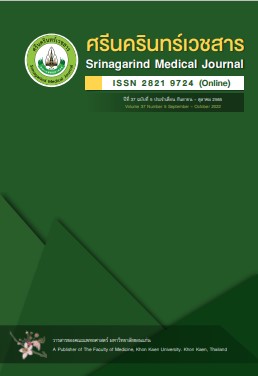ความสอดคล้องของการจำแนกระดับความรุนแรงของผู้ป่วยโรคโควิด-19 ตามเกณฑ์ของกรมการแพทย์ เปรียบเทียบกับเกณฑ์ของโรงพยาบาลกุดรัง
คำสำคัญ:
โควิด-19, โรงพยาบาลขนาดเล็ก, SARS-CoV-2บทคัดย่อ
หลักการและวัตถุประสงค์:โรคโควิด-19 เป็นโรคติดเชื้อทางเดินหายใจการจำแนกระดับความรุนแรงของผู้ป่วยที่มีประสิทธิภาพ จะช่วยจัดสรรทรัพยากรทางการแพทย์ที่มีอย่างจำกัด การศึกษานี้มีวัตถุประสงค์เพื่อศึกษาปัจจัยที่มีผลต่อความรุนแรงของโรคโควิด-19 และเปรียบเทียบความสอดคล้องของการจำแนกระดับความรุนแรงของผู้ป่วยโรคโควิด-19 ตามเกณฑ์ของกรมการแพทย์ กับเกณฑ์ของโรงพยาบาลกุดรังอำเภอกุดรัง จังหวัดมหาสารคาม
วิธีการศึกษา: เป็นการศึกษาแบบภาคตัดขวางในผู้ป่วยโรคโควิด-19 ที่มารับบริการกับทางโรงพยาบาลกุดรังระหว่างเดือนกรกฎาคม ถึง กันยายน 2564 ซึ่งถูกจัดกลุ่มด้วยเกณฑ์คัดแยกของโรงพยาบาลกุดรังเทียบกับเกณฑ์ของกรมการแพทย์ ซึ่งแบ่งออกเป็น 2 กลุ่มคือ กลุ่มสีเขียวและสีเหลือง
ผลการศึกษา: พบว่าความรุนแรงของโรคมีความสัมพันธ์อย่างมีนัยสำคัญทางสถิติ (p < 0.05) กับ อายุ ค่าความเข้มข้นของออกซิเจนในเลือดมีไข้ ไอ และลิ้นไม่ได้รสชาติและเมื่อพิจารณาความสอดคล้องของข้อมูลจากการใช้เกณฑ์ของโรงพยาบาลกุดรังเทียบกับเกณฑ์ของกรมการแพทย์พบว่ามีความสอดคล้องกันอย่างมีนัยสำคัญทางสถิติ (p< 0.01) ที่ค่าความสัมพันธ์ (kappa) 0.494 ค่าช่วงเชื่อมั่น (95%CI) 0.382-0.605
สรุป: เกณฑ์คัดกรองผู้ป่วยโรคโควิด-19 ที่พัฒนามาจากเกณฑ์ของกรมการแพทย์เพื่อให้มีความสอดคล้องกับบริบทของโรงพยาบาลชุมชนขนาดเล็ก สามารถนำมาประยุกต์ใช้ได้จริง โดยไม่ส่งผลกระทบต่อคุณภาพในการรักษาผู้ป่วย
เอกสารอ้างอิง
WHO. Coronavirus (COVID-19) Dashboard. [Internet]. 2022 [cited Jul 9, 2565]. Available from: https://covid19.who.int/
Petrosillo N, Viceconte G, Ergonul O, Ippolito G, Petersen E. COVID-19, SARS and MERS: are they closely related? ClinMicrobiol Infect 2020;26(6):729-34.
Li W, Moore MJ, Vasilieva N, Sui J, Wong SK, Berne MA, et al. Angiotensin-Converting Enzyme 2 Is a Functional Receptor for the Sars Coronavirus. Nature 2003;426(6965): 450-4.
Chu DKW, Pan Y, Cheng SMS, Hui KPY, Krishnan P, Liu Y, et al. Molecular diagnosis of a novel coronavirus (2019-nCoV) causing an outbreak of pneumonia. ClinChem2020;66(4):549-55.
Huang C, Wang Y, Li X, Ren L, Zhao J, Hu Y, et al. Clinical features of patients infected with 2019 novel coronavirus in Wuhan, China. Lancet 2020;395(10223):497-506.
Lauer SA, Grantz KH, Bi Q, Jones FK, Zheng Q, Meredith HR, et al. The incubation period of coronavirus disease 2019 (COVID-19) from publicly reported confirmed cases: estimation and application. Ann Int Med 2020;172(9):577-82.
Javanian M, Masrour-Roudsari J, Bayani M, Ebrahimpour S. Coronavirus disease 2019 (COVID-19): What we need to know. Caspian J Intern Med 2020;11(2):235-6.
Pascarella G, Strumia A, Piliego C, Bruno F, Del Buono R, Costa F, et al. COVID-19 diagnosis and management: a comprehensive review. J Intern Med 2020;288(2):192-206.
Chen N, Zhou M, Dong X, Qu J, Gong F, Han Y, et al. Epidemiological and clinical characteristics of 99 cases of 2019 novel coronavirus pneumonia in Wuhan, China: a descriptive study. Lancet 2020;395(10223):507-13.
Yang X, Yu Y, Xu J, Shu H, Xia J, Liu H, et al. Clinical course and outcomes of critically ill patients with SARS-CoV-2 pneumonia in Wuhan, China: a single-centered, retrospective, observational study. Lancet Respir Med 2020;8(5):475-81.
Wang D, Hu B, Hu C, Zhu F, Liu X, Zhang J, et al. Clinical characteristics of 138 hospitalized patients with 2019 novel coronavirus-infected pneumonia in Wuhan, China. JAMA 2020;323(11):1061-9.
Bai Y, Yao L, Wei T, Tian F, Jin DY, Chen L, et al. Presumed asymptomatic carriertransmission of COVID-19. JAMA 2020;323(14):1406-07.
Chan JF-W, Yuan S, Kok K-H, To KK-W, Chu H, Yang J, et al. A familial cluster ofpneumonia associated with the 2019 novel coronavirus indicating person-to-person transmission: a study of a family cluster. Lancet 2020;395(10223):514-23.
Department of medical. Guidelines for medical practice, diagnosis, care and prevention of infection in hospitals: In the case of patients infected with the coronavirus disease 2019 (COVID-19) for physicians and public health staff. [Internet]. 2022 [cited Jul 9, 2022]. Available from:https://covid19.dms.go.th/backend/Content/Content_File/Covid_Health/Attach/25640625085440AM_CPG_COVID_v.15_n%2020210625.pdf
Department of health. Growth standard chart for children 0-5 years old and 6-19 years old. [Internet]. 2022 [cited Jul 12, 2022]. Available from:https://nutrition2.anamai.moph.go.th/th/kidgraph
WHO expert consultation. Appropriate body-mass index for Asian populations and its implications for policy and intervention strategies. Lancet 2004;363(9403):157-63.
Onder G, Rezza G, Brusaferro S. Case-fatality rate and characteristics of patients dying in relation to COVID-19 in Italy. JAMA 2020;323(18):1775-6.
Pang WW, Pric EA, Sahoo D, Beerman I, Maloney WJ, Rossi DJ, et al. Human bone marrow hematopoietic stem cells are increased in frequency and myeloid-biased with age. Proc Natl AcadSci USA 2011;108(50): 20012-7.
Adil MT, Rahman R, Whitelaw D, Jain V, Al-Taan O, Rashid F, et al. SARS-CoV-2 and the pandemic of COVID-19. Postgrad Med J 2021;97(1144):110-6.
Kurpad AV. The requirements of protein & amino acid during acute & chronic infections. Indian J Med Res 2006;124:129-48.
Todd WTA, Lockwood DNJ, Nye FJ, Wilkins EGL, Carey PE. Infections and immune failure. Davidson’s principle and practice of medicine 19th ed. Philadelphia, United State. Elsevier Churchill Livingstone, 2002.
Aalinezhad M, Alikhani F, Akbari P, Rezaei MH, Soleimani S, Hakamifard A. Relationship between CT Severity Score and Capillary Blood Oxygen Saturation in Patients with COVID-19 Infection. Indian J Crit Care Med 2021;25(3):279-83.
GHS index. Advancing Collective Action and Accountability AMID Global Crisis. [Internet]. 2021 [cited Jul 9, 2022]. Available from: https://www.ghsindex.org/wpcontent/uploads/2021/12/2021_
GHSindexFullReport_Final.pdf
Nirattisai N, Kampangkeaw N. The challenges of Thailand’s public healthcare system during COVID-19 pandemic. J MCU Social Develop 2021;6(3):174-88.
Sathira-Angkura T, Leelawongs S, Srisuthisak S, Puttapitukpol S, Yonchoho N, Jamsomboon K. Development of nursing administration model in the COVID-19 outbreak situation of hospitals under the ministry of public health. J Health Sci 2021;30(2):320-33.
Kaewyasri K, Soontaraviratana B. The guidelines and impact from coronavirus disease (Covid-19) in Loei province. Acad J Community Public Health 2021;7(1):16-34.
ดาวน์โหลด
เผยแพร่แล้ว
รูปแบบการอ้างอิง
ฉบับ
ประเภทบทความ
สัญญาอนุญาต
ลิขสิทธิ์ (c) 2022 ศรีนครินทร์เวชสาร

อนุญาตภายใต้เงื่อนไข Creative Commons Attribution-NonCommercial-NoDerivatives 4.0 International License.




